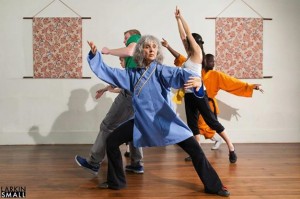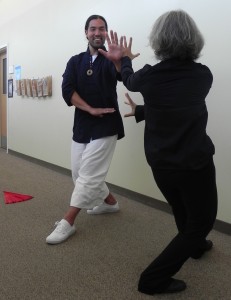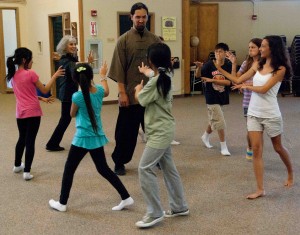- Two Becomes One
- Operator
- Turtle Races
- Lead the Follower, Follow the Leader
- Sword Fingers
- Glider
- Come Here, Go Away
- Dog Chases its Tail
- Push the Turtle

1) Two Becomes One is a guided, seated meditation. This game teaches to look within and develops mental clarity. Chinese meditation clears the mind, but this type also improves posture and physical energy. Students will have better focus after digesting their mental chatter in stillness. A straight back while poised on the edge of the chair is essential. The crown point must be lifted and the shoulders relaxed. Focus on all subsequent exercises are improved from starting with “Two Becomes One.”

2) Operator is based on standing in Wuji, (infinite emptiness), and on the idea of listening to energy. This game stimulates awareness; the ability to pay attention and to feel energy coming from other people. Students form a circle with the teacher, measuring the distance between each other by making the arms form the letter “V.” Lightly touching the centers of each other’s palms, with one side up and one side down, the teacher gives a gentle push to the student’s palm next to them as they are touching while looking directly at it. Students follow gentle pressure from palm to palm around the circle till it returns to the point of origin. Making sure the eyes follow the hands helps students to pay attention, to actively listen to energy. Teacher can follow the movement and see where it gets stuck, and where the energy flow gets broken. This occurs whenever a student is distracted and not paying attention. The same movement is done with eyes closed. The final phase is done without moving while feeling the energy circulating. This important exercise develops sensitivity to others and awareness of the feeling of energy.
 3) Turtle Races is based on the T’ai Chi core principal of slowness. Moving slowly develops patience and self-control by allowing time for the mind to direct and reflect on the body movements. Competing to be last gives students a new perspective on the rush to win and beat others. Three qualities are: Slow, Big, Quiet. A few supplemental rules for the students who may try tricks to win: Keep moving forward. No diagonal movement. Stay on your feet and don’t touch the floor. Give accolades for creativity, focus and adhering to the principles.
3) Turtle Races is based on the T’ai Chi core principal of slowness. Moving slowly develops patience and self-control by allowing time for the mind to direct and reflect on the body movements. Competing to be last gives students a new perspective on the rush to win and beat others. Three qualities are: Slow, Big, Quiet. A few supplemental rules for the students who may try tricks to win: Keep moving forward. No diagonal movement. Stay on your feet and don’t touch the floor. Give accolades for creativity, focus and adhering to the principles.
 4) Lead the Follower, Follow the Leader teaches the principles in T’ai Chi known as listening and sticking.This game encourages players to be good leaders and good followers, to be creative and good at copying; initiative and compliance. Students will instinctively assume a posture that is loose, but resilient, poised but flowing, as they lead and follow each other. This postural alignment taken instinctively while listening and adhering is known as Peng in Tai Chi lexicon. Preferably, students should stay connected at the backs of their wrists (left to left and right to right). The two students decide who leads first. After a few minutes, they switch roles. Finally, the whole exercise is done with eyes closed. The other students may stand along the walls or chairs and tell the principal players if they are getting too close. This exercise promotes the idea that in order to lead, you must be a good listener, and in order to follow, you must know what it feels like to lead. More creative energy is needed to lead than to follow, and participants get a chance to be in both roles.
4) Lead the Follower, Follow the Leader teaches the principles in T’ai Chi known as listening and sticking.This game encourages players to be good leaders and good followers, to be creative and good at copying; initiative and compliance. Students will instinctively assume a posture that is loose, but resilient, poised but flowing, as they lead and follow each other. This postural alignment taken instinctively while listening and adhering is known as Peng in Tai Chi lexicon. Preferably, students should stay connected at the backs of their wrists (left to left and right to right). The two students decide who leads first. After a few minutes, they switch roles. Finally, the whole exercise is done with eyes closed. The other students may stand along the walls or chairs and tell the principal players if they are getting too close. This exercise promotes the idea that in order to lead, you must be a good listener, and in order to follow, you must know what it feels like to lead. More creative energy is needed to lead than to follow, and participants get a chance to be in both roles.

5) Sword Fingers teaches students to turn the waist to deflect force. The notions of going- with-the-flow, non-rigidity, flexibility and change are introduced. This game takes both fine and gross motor control and takes a lot of focus. One student points towards the other’s heart with the pointer and middle finger, arm out-stretched. The evading student forms the capital letter “L” with her or his same side (lefts to lefts or rights to rights) arm. “Sword” strides towards backwards walking “Shield” until “Shield” decides to turn and attack. The hand must change (from sword fingers to open palm) when the advance turns into the retreat. Sword Fingers trains how to change direction from backwards/evading to forwards/attacking in one step and with a turn of the waist. Sword-fingers often gets students running, and is best done in a large, open space.
6) Glider is very important because it encourages sensitivity and empathy. Partners stand facing each other one arm’s length apart. Each person steps forward with the same foot in to the other’s space while the back foot remains in place. Arms are extended as if holding a tray. Partners touch each others elbows at the bottom with their middle fingers, as lightly as possible. One forearm is on top, the other is underneath. When one person shifts forward, with their center of mass over their front leg, the other person shifts weight back, center of mass over the back leg. Relaxing in close proximity with a partner, it teaches how to move smoothly with weight sunk, to breathe in and out with the movements. Yin (receive) and Yang (give) are exchanged. The partners’ movements and breathing automatically synchronizes, as does the pulse and heartbeat. When done slowly this exercise is very calming. Glider is done first with eyes open and then with eyes closed. When done with eyes closed, without the distraction of visual stimulus, the slightest deviation can be felt. Partners are able to feel little baubles and meandering, and smooth and straighten out the motion. As each person look for this in him or herself, the other person is guided to be less shaky and more centered. “Glider” is especially helpful to people with balance issues and/or brain injuries.
to the other’s space while the back foot remains in place. Arms are extended as if holding a tray. Partners touch each others elbows at the bottom with their middle fingers, as lightly as possible. One forearm is on top, the other is underneath. When one person shifts forward, with their center of mass over their front leg, the other person shifts weight back, center of mass over the back leg. Relaxing in close proximity with a partner, it teaches how to move smoothly with weight sunk, to breathe in and out with the movements. Yin (receive) and Yang (give) are exchanged. The partners’ movements and breathing automatically synchronizes, as does the pulse and heartbeat. When done slowly this exercise is very calming. Glider is done first with eyes open and then with eyes closed. When done with eyes closed, without the distraction of visual stimulus, the slightest deviation can be felt. Partners are able to feel little baubles and meandering, and smooth and straighten out the motion. As each person look for this in him or herself, the other person is guided to be less shaky and more centered. “Glider” is especially helpful to people with balance issues and/or brain injuries.
7) Come Here, Go Away is also known as “Traffic Cop.” This one teaches the the feeling of going with force until it dissipates and then sending it back without overextending. It also teaches how to expand your energy field within your own frame. You yield while still holding your ground and then you emit the energy you receive in a continuous flow. This exercise gives people the T’ai Chi feeling without much training.Kids love it.
 8) Dog Chases its Tail teachers players teamwork and to move in concert. rather like a flock of birds or school of fish, but also to initiate a change of direction. The deeper message is that when the momentum is pushing or pulling you in a certain direction, you can change the course at will. Based on Single Change Palm from Bagua, this game can be done with a partner, a small or a large group. The more people, the bigger the circle. Students simultaneously chase and are chased by one another. For this reason, students also named it Prey on Predator or Hunt the Hunter. The Leader calls for a change in direction from clockwise to counterclockwise with a U-Turn step and a turning of the palms. This game is very intense and stimulating — a good way to generate lots of focused energy. It is important to not run because the abrupt change in direction can hurt the knees.
8) Dog Chases its Tail teachers players teamwork and to move in concert. rather like a flock of birds or school of fish, but also to initiate a change of direction. The deeper message is that when the momentum is pushing or pulling you in a certain direction, you can change the course at will. Based on Single Change Palm from Bagua, this game can be done with a partner, a small or a large group. The more people, the bigger the circle. Students simultaneously chase and are chased by one another. For this reason, students also named it Prey on Predator or Hunt the Hunter. The Leader calls for a change in direction from clockwise to counterclockwise with a U-Turn step and a turning of the palms. This game is very intense and stimulating — a good way to generate lots of focused energy. It is important to not run because the abrupt change in direction can hurt the knees. Stepping should be controlled and steady, a walking pace rather than running. A music stand (or flag pole, broom, mop … even another person) in the center of the circle helps keeps the eyes focused and steady and the waist twisted. Some adults can’t do this and become dizzy and nauseous, but I have yet to see this with someone young. This Game teaches to initiate or follow abrupt changes in direction without losing balance or force.
Stepping should be controlled and steady, a walking pace rather than running. A music stand (or flag pole, broom, mop … even another person) in the center of the circle helps keeps the eyes focused and steady and the waist twisted. Some adults can’t do this and become dizzy and nauseous, but I have yet to see this with someone young. This Game teaches to initiate or follow abrupt changes in direction without losing balance or force.
 9) Push the Turtle/Don’t Break the Chain is the U-Turn step from Bagua done with a push on a rounded (turtle shell) back. The somatic message from this game is to “Go With the Flow,” to be cooperative, and to really feel the change in direction. The contact is constant, with palms on the back and rolling in the turn on the arms. This can only be accomplished by keeping the arms rounded, as in Empty Moon, Full Moon. When done with a whole group, make sure each student goes the way they are pushed in the turn. This exercise teaches how to focus on a whole group, wait for force, really feel its direction and go with it. This game teaches students to “feel which way the wind is blowing.”
9) Push the Turtle/Don’t Break the Chain is the U-Turn step from Bagua done with a push on a rounded (turtle shell) back. The somatic message from this game is to “Go With the Flow,” to be cooperative, and to really feel the change in direction. The contact is constant, with palms on the back and rolling in the turn on the arms. This can only be accomplished by keeping the arms rounded, as in Empty Moon, Full Moon. When done with a whole group, make sure each student goes the way they are pushed in the turn. This exercise teaches how to focus on a whole group, wait for force, really feel its direction and go with it. This game teaches students to “feel which way the wind is blowing.”


8 Responses to 9 Peace Games